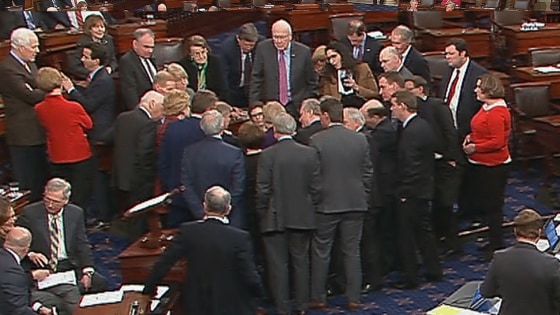TRUMP AGENDA: Here’s how the shutdown ultimately ended
Leigh Ann Caldwell, Andrew Rafferty and Alex Johnson report on how the shutdown ultimately ended.
The New York Times, on what happens next: “The passage of the measure ended an ugly, if short-lived, impasse that threatened to give a black eye to both major political parties. The deal, reached after a bipartisan group of senators pushed their leaders to come to terms, enables hundreds of thousands of federal employees who had been facing furloughs to go back to work. But a key part of the deal, a pledge by Senator Mitch McConnell, Republican of Kentucky and the majority leader, to allow an immigration vote in the coming weeks, sets the stage for a battle over the so-called Dreamers, young undocumented immigrants who were brought to the United States illegally as children.”
NBC’s Jonathan Allen: “Schumer’s rare double-buckle on the shutdown infuriates Democrats on the left”
And from the Washington Post: “This time, it was the Democrats’ turn to learn what Republicans have before them: First, that bringing the government to a halt is not an advantageous way for the opposition to force through the policy objectives it has not been able to achieve through legislating. And second, that the party that holds the White House has the upper hand.”
“The 2018 government shutdown may go down as one of the shortest, and much of the credit for that is going to a bipartisan group of senators who wrested control from their own leadership,” writes the Wall Street Journal.
What about Trump’s role? From POLITICO: “The shutdown drama taught White House aides a lesson: When it comes to President Donald Trump, sometimes less is more. For about 48 hours this weekend, Trump kept an unusually low profile, making no public appearances and keeping his direct contact with lawmakers — especially Democrats — to a minimum. Instead, the president left the heavy lifting to his staff, temporarily suppressing his instinct to invite lawmakers to the White House to strike a grand bargain.”
And in the Washington Post: “Republicans pursued a clear strategy to keep Trump contained during the three-day standoff that ended Monday — a president communicating a deliberate and simple message, while largely hidden from public view.”
What’s going to happen in the House after the Senate takes up immigration? The Washington Post: “On one hand, Ryan has repeatedly pledged to bring forth a bill protecting dreamers, and brokering a compromise could help protect GOP members running in competitive races in this year’s midterm elections. On the other hand, he has said no immigration bill can pass the House without Trump’s support, and Trump has yet to back any legislation that has the bipartisan support necessary to pass both chambers.”
From POLITICO: Tony Perkins says Trump gets “a mulligan” on questionable personal behavior.
The AP has the latest on Mike Pence’s trip to Jerusalem: “Vice President Mike Pence reiterated to Israeli leaders on Tuesday that the Trump administration plans to pull out of the landmark 2015 Iran nuclear deal unless the pact is amended.”
OFF TO THE RACES: Dem mayors with 2020 ambitions
Don’t miss the big implications from the Pennsylvania redistricting decision.
NBC’s Adam Edelman and Jonathan Allen preview the Democratic mayors with 2020 ambitions.
FL-27: Does Donna Shalala want to run for Congress?
FL-SEN: What’s the latest on Rick Scott’s potential run against Bill Nelson? The Hill checks in.
GA-GOV:POLITICO asks if this is the year Georgia’s governor’s mansion flips.
HI-GOV: Oh, boy. From the Washington Post: “Hawaii governor didn’t correct false missile alert sooner because he didn’t know his Twitter password”
VA-10: Former Biden chief of staff Susan Platt won’t challenge Barbara Comstock.
